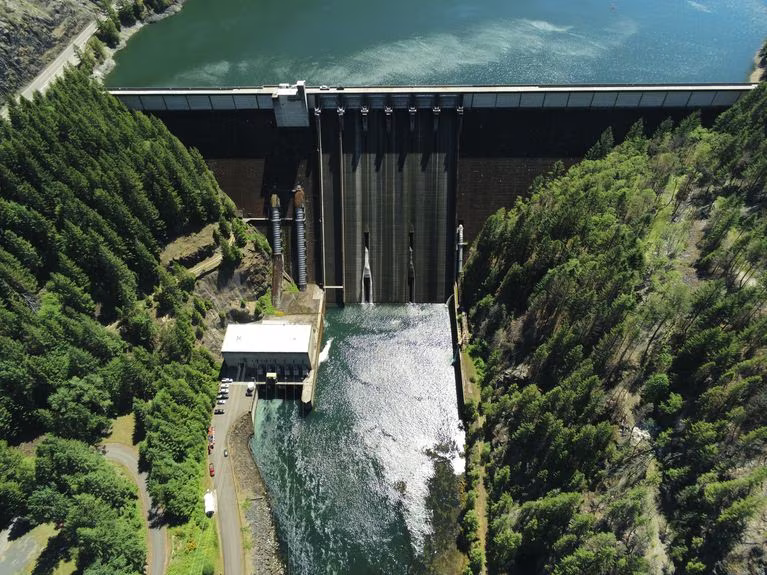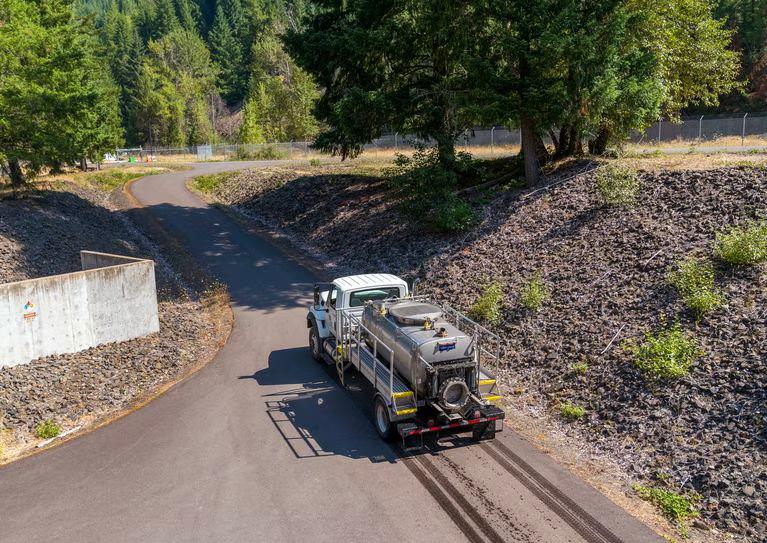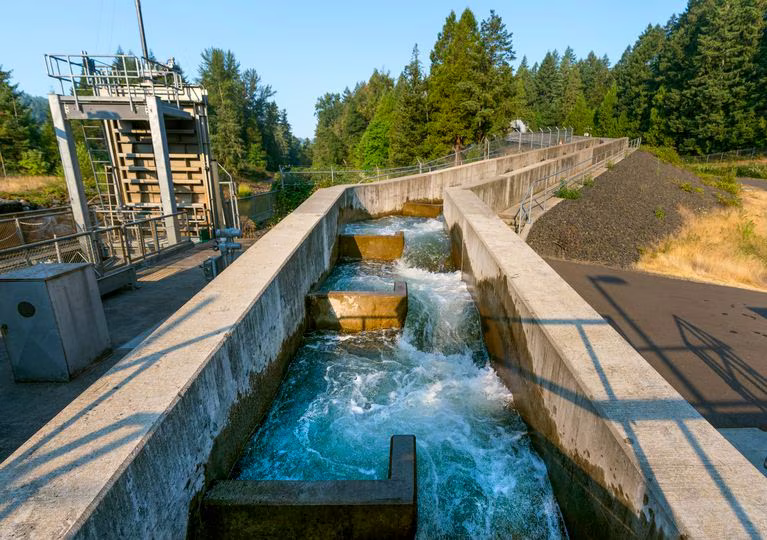Subscribe to Science Friday


This article is part of The State of Science, a series featuring science stories from public radio stations across the United States. This story, by Tony Schick, was originally published by OPB, with support from the ProPublica Local Reporting Network..
To free salmon stuck behind dams in Oregon’s Willamette River Valley, here’s what the U.S. Army Corps of Engineers has in mind:
Build a floating vacuum the size of a football field with enough pumps to suck up a small river. Capture tiny young salmon in the vacuum’s mouth and flush them into massive storage tanks. Then load the fish onto trucks, drive them downstream and dump them back into the water. An enormous fish collector like this costs up to $450 million, and nothing of its scale has ever been tested.
The fish collectors are the biggest element of the Army Corps’ $1.9 billion plan to keep the salmon from going extinct.
The Corps says its devices will work. A cheaper alternative — halting dam operations so fish can pass — would create widespread harm to hydroelectric customers, boaters and farmers, the agency contends.
“Bottom line, we think what we have proposed will support sustainable, healthy fish populations over time,” Liza Wells, the deputy engineer for the Corps’ Portland district, said in a statement.
But reporting by Oregon Public Broadcasting and ProPublica casts doubt on the Corps’ assertions.
First, some leading scientists have said the project won’t save as many salmon as the agency claims.

A comprehensive scientific review in 2017 concluded that the use of elaborate fish traps and tanker trucks to haul salmon, as the Corps proposes, will “only prolong their decline to extinction.”
Moreover, many of the interests the Corps says it’s protecting maintain they don’t need the help — not power companies, not farmers and not businesses reliant on recreational boating.
The Corps’ effort to keep its dams running full-bore is a story of how the taxpayer-funded federal agency, despite decades of criticism, continues to double down on costly feats of engineering to reverse environmental catastrophes its own engineers created.
The only peer-reviewed cost-benefit analysis of the Willamette dams, published in 2021, found that the collective environmental harms, upkeep costs and risks of collapse at the dams outweigh the economic benefits.

Congress has weighed in, twice calling on the Corps to study shutting down hydropower, which would free up more water for salmon. The agency blew its first deadline last year and now says it will perform an “initial assessment” to help decide whether to do the study required by law.
Emails obtained by ProPublica and OPB show that as Corps officials hashed out how to handle the mandate from Congress, they proposed actions that could increase public support for preserving hydropower. The Corps is now finalizing a plan that would continue electricity generation for the next 30 years.
“How can you finalize a long-term plan if you don’t know whether or not you’re going to continue hydro?” said former U.S. Rep. Peter DeFazio, D-Ore., who pushed for legislation ordering the Corps to study ending hydropower.
“They’re doing that without the study and the information they need,” he added.
Read the rest of the story via OPB.
Segment Guests
Tony Schick is a reporter with Oregon Public Broadcasting and ProPublica, based in Portland, Oregon.
Segment Transcript
IRA FLATOW: This is Science Friday. I’m Ira Flatow.
And now it’s time to check in on the State of Science–
RADIO ANNOUNCER: This is KERA–
RADIO ANNOUNCER: For WWNO–
RADIO ANNOUNCER: St. Louis Public Radio–
RADIO ANNOUNCER: Iowa Public Radio News–
IRA FLATOW: –local science stories of national significance.
Oregon’s Willamette River Valley is home to 13 dams, which have the important job of making sure water is at the right place at the right time. But these dams have the unfortunate side effect of trapping salmon and preventing them from getting where they want to go.
The US Army Corps of Engineers has a novel solution for this problem that may seem surprising– a floating vacuum the size of a football field, which will suck up the salmon, load them onto trucks, haul them down the river to be put back in.
If your reaction to this plan is “huh,” well, you’re not alone. Joining me to talk about this is Tony Schick, reporter for Oregon Public Broadcasting and ProPublica, based in Portland. Welcome back to Science Friday.
TONY SCHICK: Hey, thank you so much for having me.
IRA FLATOW: This sounds a little bit wild. Let’s start with the problem here. Of course, the fish want to go back up river and the dam is in the way– all of them, right?
TONY SCHICK: Well, the fish want to go downriver first, and they’re in the way for that, too. So the fish are born in the streams up above the dams and are trying to migrate downriver to the ocean. And the dam blocks their journey downriver and it blocks their journey upriver, too. They have been massive impediments. And they are what biologists cite as the dominant factor in driving several of these species to the Endangered List.
IRA FLATOW: Wow. But the plan I described briefly seems– if I might coin a phrase– a little bit bananas here. Tell us the details. This is really a giant fish vacuum? How big is this?
TONY SCHICK: Yeah. So that’s not me being flippant when I describe it as a fish vacuum. That’s how the Corps of Engineers’ biologists described it to me. It looks like a giant floating industrial building with fish tanks and plumbing. And what it does is it uses pumps to create an inflow of water. And so it’s sucking up water. And the idea is to create a big enough flow of water that the fish think, oh, that’s the current I’m supposed to follow downstream. Because these salmon are hardwired to make their way downstream and to follow a flowing current.
That’s part of the problem with having these reservoirs behind dams. It’s stagnant water. So it’s preventing the salmon from their typical migration downstream. And so the idea is essentially to trick these fish into thinking this is the way downstream. And then they get caught in these traps. And then they’re held in tanks. They’re transported onto a truck. And then they are driven downstream, around one dam or maybe multiple dams in some cases, and then releasing them back into the water.
And then they would then capture the adult fish, once they come back a few years later from the ocean. And that’s something they’ve been doing for a while. Adult trap and haul, as they call it, is a fairly commonly used practice for these high-head dams– the dams that are very tall and very difficult to construct some sort of fish ladder that the fish can just swim past.
IRA FLATOW: Is this the easiest solution to this problem? I mean, it sounds like you’re going to be stressing the fish and who knows what. Why has this plan gotten the most traction?
TONY SCHICK: In short, it’s not the most simple solution. There are other things you can do at a flood control dam– which these dams are primarily used for flood control. They do have other uses, but they were primarily built for flood control. And what you can do there is can open up the various gates in the dams. You can open up– they’re called regulating outlets that you use to regulate the height of the reservoir or the temperature or the flow– you can open those up and essentially drain the reservoir down to the level of those outlets so the fish can get through those outlets.
Those outlets can safely pass fish, but they’re normally at a depth that’s way too deep for salmon to get to because salmon are oriented to the surface. And so if you just drain those to the point where the salmon can find them, you can pass a lot of fish. And at some of these dams– at one in particular– they have experimented with draining the reservoir all the way basically to the creek bed. And they have a dam where it’s configured in a way that it can facilitate that. And they’ve seen tremendous success with passing fish.
And the Corps reports that they have seen a 10-fold increase in the number of adult salmon coming back at that dam– it’s called Fall Creek Dam– because of draining the reservoir. And what that does is it flushes all of the fish downstream. They have 99% successful passage.
It also restores– temporarily at least– river conditions. And so you’re getting rid of the reservoir temporarily and so you don’t have the reservoir conditions, where invasive species– like bass or Northern pikeminnow that really like those warmer stagnant lakes– it’s getting rid of a lot of those. And so the reservoir becomes not so perilous for salmon.
IRA FLATOW: Right. Well, if that works so well, why go to this kind of scale? I mean, it doesn’t seem like this is going to be sustainable in the long run.
TONY SCHICK: Well, there are a couple of reasons. One is the Army Corps says they’re operating within a box that Congress has designed for them in terms of how they can operate. So they have all of these uses authorized for the dams– storing water, hydropower, recreation. And if you’re draining the reservoirs, that is sacrificing those other uses. And the Corps says that they’re not able to do that or allowed to do that and sacrifice all of these other uses because they are uses that Congress has authorized for them. And until Congress says otherwise, that’s what they’re going to do.
IRA FLATOW: Yeah. What’s the projection, though, for how many fish the Army Corps’ project will save?
TONY SCHICK: So their projections are that these fish collectors can collect somewhere between 80 and 90-some percent of fish.
IRA FLATOW: And will this actually stop the possible extinction of the fish if you can get that?
TONY SCHICK: The Corps says so. There are a lot of people who are more skeptical of that. So at a couple of these locations where they’re trying these fish collectors, it’s going to result in two-way trap and haul. As I described, you trap the juvenile fish, truck them downstream. You trap the adult fish, bring them back up.
There was a review of this in 2017 by some researchers at University of California-Davis, where they examined this in the context of it being proposed for salmon in California. And they concluded that there is no such program that can be considered a success of this two-way trap and haul. They said any such program should proceed with extreme caution– those are their words– and in conclusion, they said it won’t save salmon. It will merely prolong their path to extinction.
Now, I will say the Corps’ biologist in the area, Greg Taylor, has been frank with me about the uncertainties involved in their plan.
GREG TAYLOR: You don’t have to be a rocket scientist to go back and look at how these structures have performed in other locations to see that there’s been some challenges. So what we can do, and what we have done, is gone back and look really hard at those designs and tried to incorporate every single thing we think can help a structure at our site collect fish in the most efficient way possible to be successful.
TONY SCHICK: Yeah. So these fish collectors have a really spotty track record. There are some that have been successful. There was one on the Clackamas River, which is also on the Willamette system, owned by a private company, that has been quite successful. The difference is that’s a very small reservoir. It doesn’t fluctuate up and down like these flood control reservoirs do.
And it also operates what’s called run of river. Basically, the water that comes in flows out. They’re not impounding lots of water behind the dams, creating this stagnant lake. So they have all of these things going for them at this dam that the Army Corps’ Willamette dams don’t have. And they’re aware of that.
IRA FLATOW: So what’s next for this plan? Is it still going strong? Can we expect an update?
TONY SCHICK: So the Corps has to finalize its plan for Willamette River salmon by the end of 2024 under a court order. And the next step is it has to get approved by the National Oceanic and Atmospheric Administration, or NOAA. And NOAA scientists said that they are confident in these fish collectors; that they believe that the Corps can improve on designs they’ve seen elsewhere and that they do have confidence that it will work.
IRA FLATOW: Well, we’ll check in and check back with you, Tony, OK? Thanks for taking time to be with us today.
TONY SCHICK: Thanks so much. Take care.
IRA FLATOW: Tony Schick, reporter for Oregon Public Broadcasting and ProPublica, based in Portland, Oregon.
Copyright © 2023 Science Friday Initiative. All rights reserved. Science Friday transcripts are produced on a tight deadline by 3Play Media. Fidelity to the original aired/published audio or video file might vary, and text might be updated or amended in the future. For the authoritative record of Science Friday’s programming, please visit the original aired/published recording. For terms of use and more information, visit our policies pages at http://www.sciencefriday.com/about/policies/
Meet the Producers and Host
About Kathleen Davis
Kathleen Davis is a producer and fill-in host at Science Friday, which means she spends her weeks researching, writing, editing, and sometimes talking into a microphone. She’s always eager to talk about freshwater lakes and Coney Island diners.
About Ira Flatow
Ira Flatow is the founder and host of Science Friday. His green thumb has revived many an office plant at death’s door.